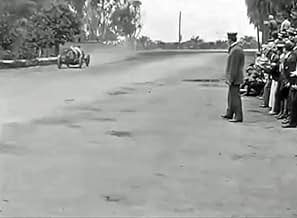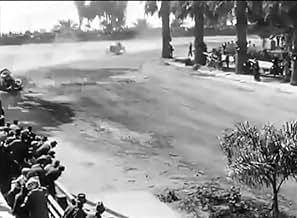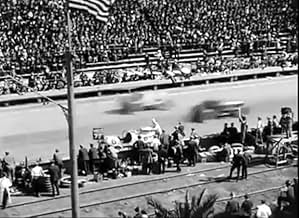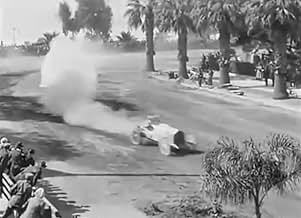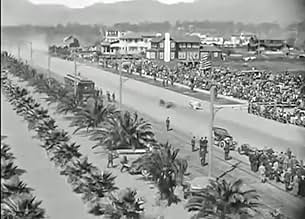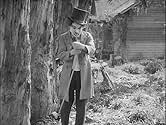Ajouter une intrigue dans votre langueCharlie, competing with his rival's race car, offers Mabel a ride on his motorcycle but drops her in a puddle. He next joins some dubious characters in abduction of his rival just before the... Tout lireCharlie, competing with his rival's race car, offers Mabel a ride on his motorcycle but drops her in a puddle. He next joins some dubious characters in abduction of his rival just before the race for the Vanderbilt Cup. With her boyfriend locked up in a shed, Mabel takes his plac... Tout lireCharlie, competing with his rival's race car, offers Mabel a ride on his motorcycle but drops her in a puddle. He next joins some dubious characters in abduction of his rival just before the race for the Vanderbilt Cup. With her boyfriend locked up in a shed, Mabel takes his place. Charlie does what he can to sabotage the race, even causing Mabel's car to overturn.
- Réalisation
- Scénario
- Casting principal
- Henchman
- (as Andy Anderson)
- Cheering Spectator
- (non crédité)
- Spectator in Grandstand
- (non crédité)
- Mabel's friend and race spectator
- (non crédité)
- Race Spectator
- (non crédité)
- Spectator in Grandstand
- (non crédité)
- Spectator in Grandstand
- (non crédité)
- Spectator in Grandstand
- (non crédité)
- Cheering Spectator
- (non crédité)
- Henchman
- (non crédité)
Avis à la une
The story is clear, not overly confusing plus the racing sequences are very interesting. It seems that there was more effort put into this one than many other Keystone productions. It might be because Mable Normand directed this film together with Mack Sennet. Mable, being a star, wanted a more polished film.
'Mabel at the Wheel' is one of the best early Chaplin's movies and probably my favorite Mabel Normand movie. It was his eleventh film - imagine - making eleven movies within barely three months. What a schedule.
I hereby recommend reading wmorrow59 review which shares some light behind the scenes on how Mabel and Chaplin didn't get along.
In an article called "Speeding Sweethearts of the Silent Screen," film historian William Drew notes that after Mary Pickford's car chase movie "A Beast At Bay" (Griffith, 1912), this is only the third movie to feature a woman's driving. It will only become standard in movies starting in 1915. Drew notes, "In fact, one can view Mabel at the Wheel as a kind of feminist parable with the heroine defeating the male competitors on the race course as well as the villainous Chaplin." Besides seeing Mabel Normand's feminist heroics, the other reason this film, directed by Ms. Normand, is noteworthy is Chaplin's unique performance. He plays the villain wearing a trench coat and whiskers. Through much of the film, he does what seems like a perfect impression of comedian Ford Sterling. At one point, Chaplin even crosses his eyes like Sterling. It should be remembered that Chaplin was hired at Keystone to replace Ford Sterling. In fact Chaplin's tramp costume uses Sterling's large size shoes, perhaps symbolizing the fact that he was hired to fill Sterling's shoes literally as well as figuratively.
The first five minutes of the film is quite different from the rest. Chaplin plays simply Harry McCoy's rival for Mabel Normand. This is exactly the same triangle we saw in Chaplin's first film, "Making a Living." The second five minutes of the film is different with Chaplin suddenly turning into a ridiculous villain caricature. He goes around jabbing people and tires with a pin.
There is a scene where Chaplin takes out a water hose to water a race car course. Apparently, Chaplin refused to do it. Chaplin probably did not see the humor in endangering people's lives. Slapping, punching, pricking and kicking people is one thing, but actually endangering people's lives is another. He worked off the set.
Famously, Mack Sennett threatened to fire him. He submitted and played the rest of the movie as Normand wanted him to, in Ford Sterling absurdist style. We should remember that Chaplin's humor was based on the funny drunk sketch he made famous. The drunk is funny, but not absurd. The absurd humor that Keystone dealt with was simply not something that Chaplin appreciated.
This is really a Mabel Normand film and it seems unfair to give Sennett credit for directing it when all he did was discipline Chaplin. Normand had her own problems with Sennett and was probably only staying with him at the time because he gave her the opportunity to direct.
There are some powerful images in the film: Mabel falling off a motorcycle, Mabel behind the wheel of the car with mechanic William Hauber, Charlie sitting next to Mabel and jabbing her with a pin and her jabbing him right back, and Mack Sennett as a country bumpkin in a cameo appearance. It seems possible that Mabel was expressing how she really felt about Sennett by having him act this way.
The original film was 1900 feet and the restored version is about 1400. Please keep in mind that over 25% of the film is still missing. Probably the jumpy, quick shots in the racing scenes were much smoother with longer shots in the original.
Sennett supposedly got a telegram from his partners in New York demanding more Chaplin films during the production of this film and only this telegram stopped him from firing Chaplin. I tend to think that it was the success of this movie that really put Chaplin on the map. While Chaplin was fine in his first ten films, there was nothing particularly distinguishing about him. This two-reeler would have established him as the real replacement for the popular Ford Sterling.
** 1/2 (out of 4)
The behind the scenes issues with this movie are pretty interesting but from what I've read Chaplin hated being directed by a woman and his constant battles with Normand almost got him fired. For whatever reason Keystone decided to keep him and Chaplin's hatred of "other directors" finally caused him to be directed by himself from this point on in his career. In the film Mabel and her boyfriend (Harry McCoy) have a falling out so she takes a ride with his rival (Chaplin) but she eventually gets knocked off his bike and into a puddle of mud. Later she's back with the boyfriend who's at a race track when Chaplin kidnaps him forcing Mabel to race the car. This is a mixed bag as far as the film goes because the first half is pretty funny but the second half dealing with the race falls apart. Seeing Chaplin and Mabel slap one another makes you wonder how much they both enjoyed it but these early scenes are certainly the best in the film. The actual auto race wasn't too thrilling or funny to me but things do pick up towards the end and Chaplin's final scene is very funny.
Le saviez-vous
- AnecdotesThe motorcycle in the opening scene is a Thor Motorcycle Model M Type IV.
- GaffesIn the hilarious scene where Mabel gets dropped in the mud puddle, and where she splashes around getting out/up, she is clearly soaked. Immediately after, when Harry McCoy rolls up in the race car, Mabel runs up to him, and despite some splashes on her dress, she is more or less dry.
- ConnexionsFeatured in Charlie Chaplin, l'homme le plus drôle du monde (1967)
Meilleurs choix
Détails
- Date de sortie
- Pays d’origine
- Sites officiels
- Langues
- Aussi connu sous le nom de
- Mabel at the Wheel
- Lieux de tournage
- Société de production
- Voir plus de crédits d'entreprise sur IMDbPro
- Durée23 minutes
- Couleur
- Mixage
- Rapport de forme
- 1.33 : 1

